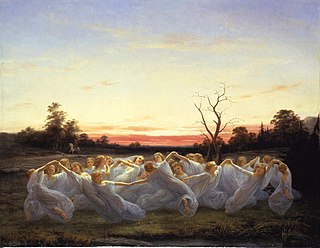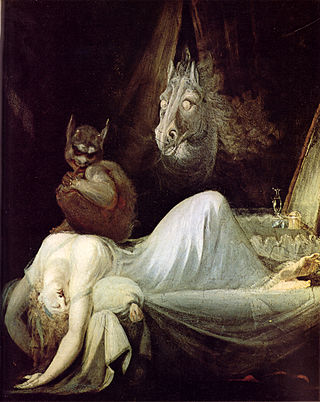
A demon is a malevolent supernatural entity. Historically, belief in demons, or stories about demons, occurs in religion, occultism, literature, fiction, mythology, and folklore; as well as in media such as comics, video games, movies, and television series.

A dragon is a magical legendary creature that appears in the folklore of multiple cultures worldwide. Beliefs about dragons vary considerably through regions, but dragons in Western cultures since the High Middle Ages have often been depicted as winged, horned, and capable of breathing fire. Dragons in eastern cultures are usually depicted as wingless, four-legged, serpentine creatures with above-average intelligence. Commonalities between dragons' traits are often a hybridization of feline, reptilian, mammalian, and avian features. Some scholars believe large extinct or migrating crocodiles bear the closest resemblance, especially when encountered in forested or swampy areas, and are most likely the template of modern Asian dragon imagery.

An elf is a type of humanoid supernatural being in Germanic folklore. Elves appear especially in North Germanic mythology, being mentioned in the Icelandic Poetic Edda and Snorri Sturluson's Prose Edda.

Jinn – also romanized as djinn or anglicized as genies – are invisible creatures in early religion in pre-Islamic Arabia and later in Islamic culture and beliefs. Like humans, they are accountable for their deeds and can be either believers (Muslims) or disbelievers (kafir), depending on whether they accept God's guidance. Since jinn are neither innately evil nor innately good, Islam acknowledged spirits from other religions and was able to adapt them during its expansion. Jinn are not a strictly Islamic concept; they may represent several pagan beliefs integrated into Islam. To assert a strict monotheism and the Islamic concept of tawhid, Islam denies all affinities between the jinn and God, thus placing the jinn parallel to humans, also subject to God's judgment and afterlife. The Quran condemns the pre-Islamic Arabian practice of worshipping or seeking protection from them.

A fairy is a type of mythical being or legendary creature, generally described as anthropomorphic, found in the folklore of multiple European cultures, a form of spirit, often with metaphysical, supernatural, or preternatural qualities.

A pixie is a mythical creature of British folklore. Pixies are speculated to be particularly concentrated in the high moorland areas around Devon and Cornwall, suggesting some Celtic origin for the belief and name. However, the word 'pixie' also appears in Dorset, Somerset and to a lesser extent in Sussex, Wiltshire and Hampshire.

In Breton folklore, a Korrigan is a fairy or dwarf-like spirit. The word korrigan means in Breton "small-dwarf". It is closely related to the Cornish word korrik which means gnome. The name changes according to the place. Among the other names, there are korrig, korred, korrs, kores, couril, crion, goric, kornandon, ozigan, nozigan, teuz, torrigan, viltañs, poulpikan, poulpiquet, and paotred ar sabad.

The kallikantzaros is a malevolent creature in Southeast European and Anatolian folklore. Stories about the kallikantzaros or its equivalents can typically be found in Greece, Bulgaria, Turkey, Serbia, Albania, Bosnia, and Cyprus. Kallikantzaroi are believed to dwell underground but come to the surface during the twelve days of Christmas, from 25 December to 6 January.
Magical creatures are an aspect of the fictional Wizarding World contained in the Harry Potter series and connected media originally created by British author J. K. Rowling. Throughout the seven main books of the series, Harry and his friends encounter many of these creatures on their adventures in Hogwarts, the Forbidden Forest, or other locations throughout the Wizarding World. In addition, students learn to take care of creatures such as hippogriffs and unicorns in the Care of Magical Creatures class at Hogwarts. Rowling has also written Fantastic Beasts and Where to Find Them, a guide to the magical beasts found in the series, and based on the fictional textbook of the same name written by Newt Scamander and used by students at Hogwarts.
Haitian mythology consists of many folklore stories from different time periods, involving sacred dance and deities, all the way to Vodou. Haitian Vodou is a syncretic mixture of Roman Catholic rituals developed during the French colonial period, based on traditional African beliefs, with roots in Dahomey, Kongo and Yoruba traditions, and folkloric influence from the indigenous Taino peoples of Haiti. The lwa, or spirits with whom Vodou adherents work and practice, are not gods but servants of the Supreme Creator Bondye. A lot of the Iwa identities come from deities formed in the West African traditional regions, especially the Fon and Yoruba. In keeping with the French-Catholic influence of the faith, Vodou practioneers are for the most part monotheists, believing that the lwa are great and powerful forces in the world with whom humans interact and vice versa, resulting in a symbiotic relationship intended to bring both humans and the lwa back to Bondye. "Vodou is a religious practice, a faith that points toward an intimate knowledge of God, and offers its practitioners a means to come into communion with the Divine, through an ever evolving paradigm of dance, song and prayers."
The iele are feminine mythical creatures in Romanian mythology. There are several differing descriptions of their characteristics. Often they are described as faeries, with great seductive power over men, with magic skills and attributes similar to nymphs, naiads and dryads found in Greek mythology.
Religious views on love vary widely between different religions.

An Alp is a supernatural being in German folklore.
The Vainakh peoples of the North Caucasus were Islamised comparatively late, during the early modern period, and Amjad Jaimoukha (2005) proposes to reconstruct some of the elements of their pre-Islamic religion and mythology, including traces of ancestor worship and funerary cults. The Nakh peoples, like many other peoples of the North Caucasus such as Circassians, practised tree worship, and believed that trees were the abodes of spirits. Vainakh peoples developed many rituals to serve particular kinds of trees. The pear tree held a special place in the faith of Vainakhs.
The drangùe is a semi-human winged divine hero in Albanian mythology and folklore, associated with weather and storms. Babies destined to become drangue are born with their heads covered in caul and with two or sometimes four wings under their arms. The drangue hold supernatural powers, especially in the wings and arms. A drangùe is made invulnerable by the singular conjunction produced at his birth, and can die only if this conjunction is repeated once again. The main goal of the drangue is to fight the kulshedra in legendary battles. He uses meteoric stones, lightning-swords, thunderbolts, piles of trees and rocks to defeat the kulshedra and to protect mankind from storms, fire, floods and other natural disasters caused by her destructive power. Heavy thunderstorms are thought to be the result of their battles. The drangue and their myth are extensively and accurately portrayed in the Albanian folk tale "The Boy who was Brother to the Drague".

A shaitan or shaytan is an evil spirit in Islam, inciting humans and jinn to sin by whispering in their hearts. Although invisible to humans, shayatin are imagined to be ugly and grotesque creatures created from Hellfire.

Zojz is a sky and lightning god in Albanian pagan mythology. Regarded as the chief god and the highest of all gods, traces of his worship survived in northern Albania until the early 20th century, and in some forms still continue today.